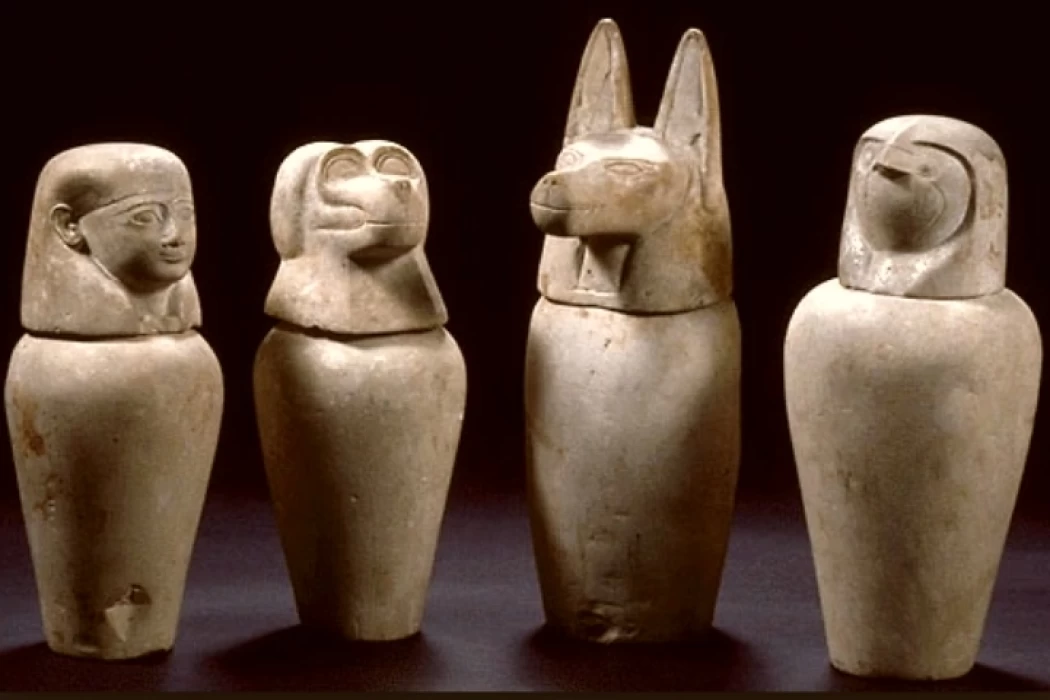
Die vier Söhne des Horus
Die vier Söhne des Horus sind vier der kosmischen Kräfte (Nitro), die sowohl mit Horus als auch mit Osiris in Verbindung gebracht wurden und eine wichtige Rolle beim Übergang des Menschen nach dem Tod von der materiellen Welt in die andere Welt spielten.
Gott Osiris | Ägyptischer Gott des Jenseits und der Auferstehung
Die vier Söhne des Horus erschienen in der berühmten Gerichtsszene, und der altägyptische Künstler stellte sie so dar, dass sie auf einer Lotusblume standen, die aus dem Wasser unter dem Thron des Osiris in der anderen Welt wuchs.
Und da die Lotusblume nach Ansicht der alten Ägypter mit der Erschaffung des Universums in Verbindung gebracht wurde, sind auch die vier Söhne des Horus Teil des Systems der Erschaffung des Universums.
Der belgische Ingenieur Robert Boval sagt, dass die vier Söhne des Horus die vier Sterne sind, die den Hohlraum bilden, der der Schöpfkelle im Großen Wagen ähnelt, und dass die Sternengruppe bei den alten Ägyptern große Bedeutung hatte.
Das Werkzeug, das beim Ritual des Öffnens des Mundes verwendet wurde, war ein Eisenwerkzeug in Form des Großen Wagens.
Horus war der erste, der das Ritual des Öffnens des Mundes durchführte. Er führte es für seinen Vater Osiris durch und benutzte dabei die Gruppe des Großen Wagens, ein Ritual, das mit der Veränderung des menschlichen Bewusstseins zusammenhängt, um sich für das Leben in einer anderen Welt zu qualifizieren, die sich von der auf der Erde gewohnten völlig unterscheidet.
Die Gruppe des Großen Bären wurde in den Texten der Pyramiden als eine der Stationen erwähnt, die die Seele auf ihrer Reise in die andere Welt durchläuft.
Die vier Söhne des Horus wurden auch mit den menschlichen Eingeweiden in Verbindung gebracht.
Bei der Mumifizierung der Mumie im alten Ägypten wurden die Eingeweide des Verstorbenen entnommen und in vier Gefäße, so genannte Kanopen, gefüllt. Jedes Gefäß trägt den Kopf eines der vier Söhne des Horus und bewacht einen der menschlichen Eingeweide. Er bewacht auch das Tor zu einer der vier ursprünglichen Seiten.
Die Namen der vier Söhne des Horus sind:
Dwamotif: Er trägt den Kopf eines Schakals und bewacht den Magen und steht am nördlichen Tor
Kabeh-Sunuf: Er trägt einen Falkenkopf, bewacht die Eingeweide und steht am Südtor.
Hapi: Er trägt den Kopf eines Pavians, bewacht die Lunge und steht am Osttor
Amsit: Er trägt einen Menschenkopf, bewacht die Leber und steht am westlichen Tor.
Ist es sicher, nach Ägypten zu reisen?
The four sons of Horus are four of the cosmic powers (nitro) that were associated with both Horus and Osiris and had a major role in the transition of man upon death from the material world to the other world.
The four sons of Horus appeared in the famous trial scene, and the ancient Egyptian artist portrayed them as they were standing on a lotus flower that grew from the water under the throne of Osiris in the other world.
And since the lotus flower, according to the ancient Egyptians, was associated with the creation of the universe, the four sons of Horus are also part of the system of the creation of the universe.
The Belgian engineer, Robert Boval, says that the four sons of Horus are the four stars that make up the cavity that resembles the ladle in the Big Dipper group, and that the star group occupied great importance among the ancient Egyptians.
The four sons of Horus were also associated with the human bowels.
When the mummy was mummified in ancient Egypt, the bowels of the deceased were taken out and placed in four pots called canopic pots. Each pot carries the head of one of the four sons of Horus and guards one of the human guts. It also guards the gate to one of the four original sides.
The liver, lungs, intestines, and stomach were among the organs of the deceased that were removed and wrapped separately during the mummification process in ancient Egypt. These components were subsequently put in four jars called canopic jars.
Known since the Old Kingdom and beyond, these jars have changed slightly over time. The lids of these jars were first shown in the New Kingdom as the "Four Sons of Horus," who protected the within.
From the earliest appearance of the Sons of Horus in ancient Egyptian imagery until the end of the Second Intermediate Period, they were mostly depicted with human heads.
When the Four Sons of Horus were depicted in human form, Imsety's head was depicted as a light-skinned, beardless female, while the other heads were depicted as dark red or black, adorned with the divine beard, meaning they were male deities.
With the beginning of the New Kingdom, another form became prevalent, but without completely overshadowing the ancient form of human-headed headdresses. Animal heads were used in place of the masculine deities' heads.
Between the beginning of the Eighteenth Dynasty and the middle of the Nineteenth Dynasty, each of the Four Sons of Horus took on its distinctive animal form.
There are a few exceptions to this. In one instance, Duamutef and Qebehsenuaf had their heads swapped, with the former depicted with the head of a falcon and the latter with the head of a jackal. This confusion occurred more than once throughout the Pharaonic era, and there are numerous and varied examples of this, some of which we will review below.
The number 4 likely represents the four cardinal points of the universe, which typically housed the body parts of the deceased god Osiris, and which were later reunited during the rituals of Osiris's resurrection in the month of Kiahk. Given that Horus had four sons, it was natural to associate them with the four cardinal points... However, they initially seemed to be associated only with the north and south, and in fact, religious texts conflict with each other on this matter.
While the Pyramid Texts indicate their southern origin, one of their incantations states, "Recite: May these four southerners stand for Neith this Amsety, Hapy, Duamutef, Qebeh-senuef—the sons of Horekhem."
We find the Book of the Dead referring in Chapter (17) to their association with the north. The text states: "They are Imsety, Hapy, Duamutef, and Qebehsenuef, who stand behind the Great Bear in the northern sky."
Meanwhile, the scenes depicted on the walls of King Ay's tomb in the Valley of the Kings show Imsety and Hapy's association with the north only, and Duamutef and Qebehsenuef's association with the south... Imsety and Hapy, representing the north, are depicted wearing the red crown, while Duamutef and Qebehsenuef, representing the south, are depicted wearing the white crown... The spirits of Imsety and Hapy may emphasize their link with the north, whereas the spirits of Nekhen—a subject we will address in a later chapter—highlight Duamutef and Qebehsenuef's association with the south. Soon, the Sons of Horus were associated with the four cardinal directions, not just as representatives of the north and south, but as representatives of the four pillars of heaven.
The names of the four sons of Horus are:
Dwamotif: He carries the head of a jackal and guards the stomach and stands at the northern gate
Kabeh-Sunuf: He carries a falcon's head and guards the bowels and stands at the southern gate
Hapi: He carries the head of a baboon, guards the lungs, and stands at the eastern gate
Amsit: He carries a human head and guards the liver and stands at the western gate















